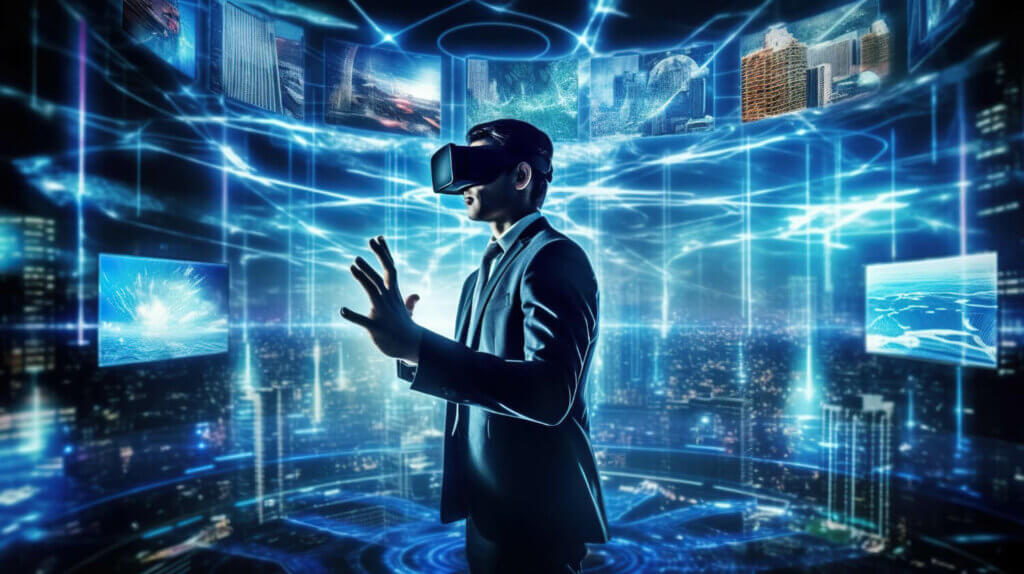In the ever-evolving landscape of technology, the concept of the metaverse has captured the imagination of many. It represents a virtual realm where users can interact, work, play, and create in ways previously only imaginable in science fiction. But what exactly is the metaverse, and what does it hold for us in the future?
Introduction to the Metaverse
The metaverse is a collective virtual shared space, created by the convergence of virtually enhanced physical reality and persistent virtual reality. It’s a concept that transcends the boundaries of traditional online experiences, offering a seamless integration of virtual worlds, augmented reality, and the internet. Think of it as a parallel digital universe where users can immerse themselves in alternate realities, interact with other users, and engage in a wide range of activities.
Real-World Scenarios

Imagine a world where you can attend a business meeting in a virtual boardroom, explore distant planets with friends, or even try on clothes in a virtual fitting room before making a purchase. These are just a few examples of the countless possibilities that the metaverse presents.
One real-world scenario where the metaverse is already making an impact is in the realm of virtual events. With the COVID-19 pandemic limiting in-person gatherings, businesses and organizations have turned to virtual platforms to host conferences, concerts, and trade shows. These virtual events often incorporate elements of the metaverse, allowing attendees to navigate virtual environments, interact with other participants, and even customize their avatars.
Let’s get Technical!
At its core, the metaverse relies on a complex amalgamation of cutting-edge temchnologies. Among these technologies, one pivotal aspect facilitating the seamless integration and interoperability of virtual worlds and platforms is the Open Metaverse Interoperability Protocol (OMIP).
OMIP serves as a standardized framework designed to enable seamless communication and interaction between various virtual environments, regardless of their underlying technologies or platforms. Think of it as the lingua franca of the metaverse, ensuring that users can effortlessly traverse different digital realms without encountering compatibility issues or barriers.
At its essence, OMIP functions as the backbone of the metaverse, facilitating the exchange of data, assets, and interactions across disparate virtual landscapes. Through a standardized set of protocols and interfaces, OMIP enables users to seamlessly transition between different virtual environments, preserving their digital identity, assets, and interactions along the way.
One of the key functionalities of OMIP is its role in enabling cross-platform compatibility and interoperability. By establishing common standards and protocols for data exchange and communication, OMIP empowers developers to create immersive experiences that transcend the limitations of individual platforms or ecosystems. This interoperability not only enriches the user experience but also fosters collaboration and innovation within the broader metaverse ecosystem.
Moreover, OMIP plays a crucial role in ensuring the security and integrity of transactions and interactions within the metaverse. Through robust encryption and authentication mechanisms, OMIP safeguards users’ digital assets and identities, mitigating the risk of fraud, theft, or unauthorized access.
If you’re interested in learning more about the Open Metaverse Interoperability Protocol (OMIP), there are several resources available online. You can find more information on the following:
- Open Metaverse Interoperability Group – omigroup.org
- Open Metaverse Interoperability Group (OMI) – GitHub
- Open Metaverse Interoperability (OMI) – Austin Tate’s Blog.
The OMI Protocol was developed by the Open Metaverse Interoperability Group (OMI Group). Like the OMI Group, there are other organizations that are actively involved in shaping metaverse standards. These include:
- Metaverse Standards Forum/Committee – Facilitates collaboration among standards organizations and businesses to advance interoperability standards for an inclusive metaverse. Through practical projects, it aims to expedite the development and implementation of these standards.
- The Khronos Group: Known for developing open standards for graphics and parallel computing, Khronos has initiatives like the Vulkan API and OpenXR, which are relevant to the metaverse.
- The Immersive Digital Experiences Alliance (IDEA): This alliance focuses on developing specifications for immersive media formats, which are important for creating rich virtual experiences in the metaverse.
- IEEE Virtual Reality and Augmented Reality Standards Committee: This committee works on developing standards related to virtual reality (VR) and augmented reality (AR) technologies, which are foundational for the metaverse.
- XR Access: A nonprofit organization advocating for inclusive design and accessibility in extended reality (XR) technologies, including those used in the metaverse.
- W3C Immersive Web Working Group: This group within the World Wide Web Consortium (W3C) focuses on standards for immersive web experiences, which are integral to the development of the metaverse on the web.
In addition to OMIP, other emerging technologies are poised to shape the future of the metaverse. Nvidia’s Omniverse, for instance, is a groundbreaking platform that leverages advanced simulation and rendering techniques to create highly realistic virtual environments. By harnessing the power of NVIDIA RTX technology and real-time ray tracing, Omniverse enables developers to create stunningly immersive experiences that blur the boundaries between the physical and digital worlds.
Another amazing development which was released very recently is Apple Vision Pro. In the broader narrative of the metaverse, Apple Vision Pro plays a significant role. As Apple continues to innovate in the realm of augmented reality (AR) and virtual reality (VR), their advancements are likely to shape the future of the metaverse. Apple Vision Pro is anticipated to offer a range of features and capabilities that will enhance the immersive experience of the metaverse, from advanced AR applications to seamless integration with Apple’s ecosystem of devices.
Expectations surrounding Apple Vision Pro include advancements in ARKit, Apple’s AR development platform, which could empower developers to create immersive and interactive experiences within the metaverse. Additionally, Apple’s emphasis on privacy and security may introduce new standards and protocols that further enhance the integrity of interactions within virtual environments.
Examples of the Metaverse in Action
Several companies are already exploring the possibilities of the metaverse and integrating it into their products and services. For example, Facebook’s parent company Meta has been investing heavily in virtual reality technology and recently rebranded itself to reflect its focus on the metaverse. Meanwhile, gaming platforms like Roblox and Fortnite have become virtual hangout spaces where users can socialize, play games, and even create their own virtual worlds.
In the world of fashion, brands like Gucci and Nike have launched virtual experiences where users can explore virtual showrooms, try on virtual clothes and accessories, and make purchases using digital currency.
Looking Ahead
As the metaverse continues to evolve, it holds the promise of revolutionizing how we interact with digital technology. From immersive gaming experiences to virtual business meetings, the metaverse offers a glimpse into a future where the boundaries between the physical and digital worlds are blurred beyond recognition. As we navigate this brave new world of immersive digital spaces, one thing is certain: the metaverse is poised to redefine the way we live, work, and play in the digital age.
